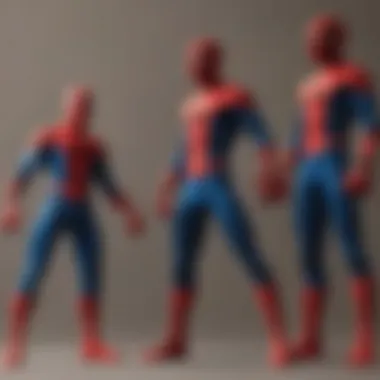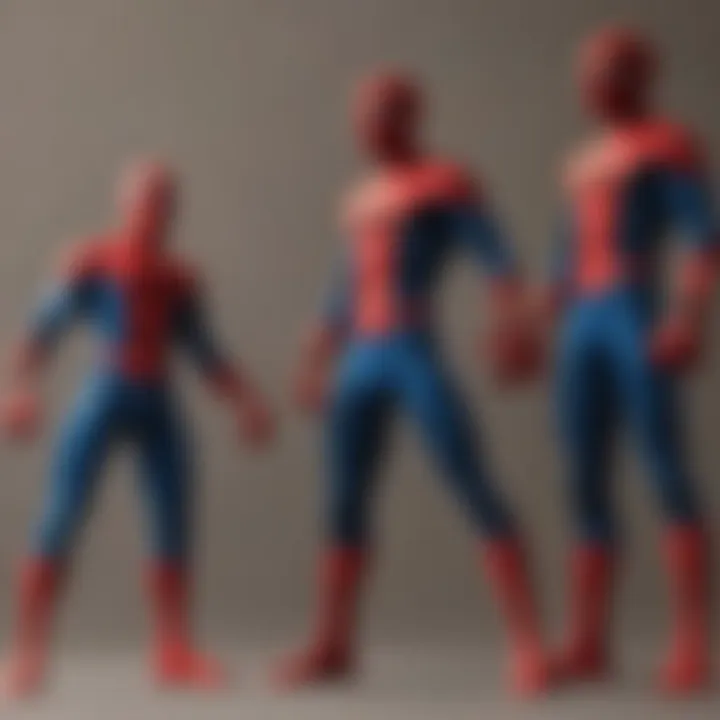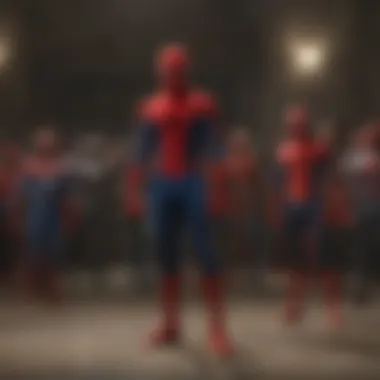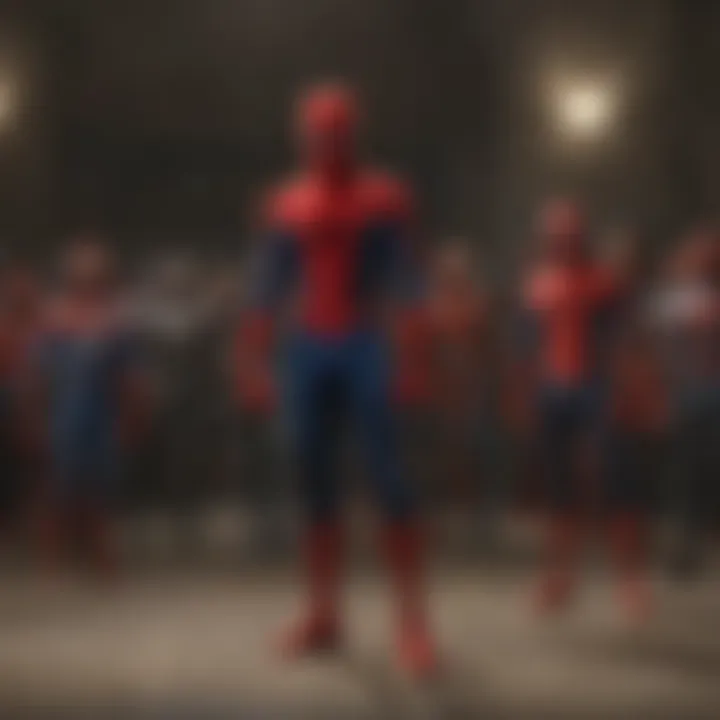Exploring Spider-Man Animation: Evolution and Impact


Intro
The world of Spider-Man animation movies is as vast and intricate as the New York City skyline. From the swinging adventures of a young hero to the deeper narratives that explore what it really means to be a hero, these films offer a unique lens through which we can discern various aspects of Spider-Man's character and legacy. Animation, in particular, has played a pivotal role in not only bringing Spider-Man’s thrilling escapades to life but also in expanding the boundaries of storytelling within the superhero genre.
Understanding the evolution of Spider-Man in animation is akin to tracing the threads of a complex web. Since his debut in comics in the 1960s, Spider-Man has evolved significantly, with various iterations gracing screens worldwide. Different animation styles have contributed to how audiences perceive him; each animation film or series constructs a narrative that resonates with viewers on multiple levels, tapping into themes of responsibility, loss, and the perpetual struggle for identity.
As we embark on an exploration of Spider-Man's animated journey, it's important to consider several crucial aspects: how his character has developed over the years, how various villains challenge him, and how fans respond across generations. Entering this spider-infested universe means delving into the character analysis, recent news about upcoming projects, a look at his rogues' gallery, and critical reviews that flesh out the viewer experience with this beloved character.
With this in mind, let’s first position ourselves in the heart of the web and explore the character of Spider-Man himself.
Prologue to Spider-Man Animation
The world of Spider-Man animation holds a special place in both pop culture and the hearts of fans. It represents a significant branch of the broader Spider-Man franchise, allowing for creative storytelling and exploration of complex characters in ways that traditional comic books might not achieve. This section aims to highlight why understanding the evolution of Spider-Man in animation is essential.
The animated format brings characters to life with dynamics that engage a broad audience—children who adore vivid colors and thrilling action, and older fans drawn to nuanced stories and themes. As we navigate the history of Spider-Man animation, it becomes clear that this format not only evolved alongside technological advancements but also intertwined with cultural transformations.
The genesis of Spider-Man in animation
Spider-Man's animation journey began in the 1960s, a time when the superhero genre was still finding its footing on television. In 1967, the first animated series hit the small screen, pulling in curious viewers. This series, though limiting due to animation techniques of the era, sparked interest and laid the groundwork for future adaptations. The character's signature web-slinging moves were animated with such flair that even the simplest frames captivated a generation.
However, these early animation efforts were not without challenges. The rigid restrictions of that time meant many comic book arcs could not be adapted fully. Characters like Green Goblin and Venom, which would become integral, weren’t prominently featured. Regardless, the show’s catchy theme song and Peter Parker's relatable struggles won fans over. Over the years, these foundational years in animation set the stage for what was to come, showing how this medium could captivate audiences in unique ways.
Transition from comics to screen
As Spider-Man transitioned from the comic book pane to the animation screen, it opened up a realm of possibilities. This change not only altered storytelling techniques but also allowed for a broader exploration of the character’s psyche.
In the comics, Spider-Man navigated personal conflicts amid battling villains. Animation amplified this storytelling; the voice of Spider-Man became infused with emotion, instilling a sense of relatability that may have been missed on the page. With stunning visuals and colorized scenes, the animated format enhanced the drama and excitement.
The 1990s series, adapted from the comics, gained popularity by introducing deeper character arcs and complex plots. This visible evolution marked a significant milestone, enabling creators to draw on rich narratives while experimenting with animation styles. It showcased how the animated world could amplify themes of identity, heroism, and responsibility, resonating with viewers of various ages.
In summary, the genesis and transition of Spider-Man from comic pages to animated sequences set a significant precedent. With animation, the Spider-Verse was constructed, not only enhancing the visual storytelling but also enriching the narrative depth surrounding this beloved character.
"Spider-Man embodies the dichotomy of heroism and human struggles, a theme beautifully brought to life in animation."
The legacy of Spider-Man animation is expansive, integrating fan desires and creative expression, but it takes root in these early foundations.
A Timeline of Key Spider-Man Animated Films
The journey of Spider-Man's animation is not just a collection of films; it’s a tapestry woven with threads of creativity, technological progress, and cultural resonance. The timeline of key Spider-Man animated films represents significant moments that have shaped the character’s portrayal in animation. This section delves into how these films have evolved, revealing a narrative reflective of societal changes, advancements in animation techniques, and the demands of diverse audiences. Understanding this timeline helps to contextualize the influence of animation on superhero stories, as well as its place in pop culture.
Early adaptations and their significance
Looking back, one can't ignore the impact of the early adaptations, which laid the foundation for future endeavors. From the initial animated shorts of the 1960s, Spider-Man swung into living rooms through the limited animation typical of the time. These shorts, though simple, tapped into a growing fandom for comic book heroes, catching the eyes of viewers who had only imagined Spider-Man’s world through printed panels. Following that, the 1994 television series offered richer narratives and character development, setting a standard for Spider-Man’s animated presence. This series also popularized iconic story arcs, like the famous "Night Gwen Stacy Died" storyline, opening the door for more mature themes.
Moreover, the significance does not solely rest on nostalgia; these early adaptations resonate through successive interpretations. They paved the way for complex storytelling and character arcs that engage viewers long after the credits roll. The early efforts serve as reminders that animation is not just for kids, and superhero stories can have depth and weight in any format. The reception of these early adaptations also sparked deeper discussions about identity and heroism that resonate with audiences even today.
The rise of CGI in Spider-Man animation
As animation technology progressed, the rise of CGI marked a pivotal shift in how Spider-Man was represented on screen. Films like "Spider-Man: The New Animated Series" in 2003 attempted to capitalize on the advancements in computer-generated imagery, bringing dynamic action scenes that were previously challenging to create. CGI allowed for greater fluidity and realism in movement, enabling Spider-Man’s acrobatics to capture his web-swinging essence more authentically.
This change wasn’t just technical; it transformed narratives as well. The inclusion of 3D environments opened up new storytelling possibilities, allowing creators to explore intricate and expansive worlds unlike anything seen in traditional animation. With CGI, audiences were treated to a visual feast that showcased epic battles, enhanced character expressions, and vibrant settings.
In addition to reinventing how we see Spider-Man, CGI’s growth has also influenced audience expectations. With stunning visuals becoming a norm, there’s an underlying pressure on animators to continually push boundaries. As a result, films like "Spider-Man: Into the Spider-Verse" stand as testaments to the possibilities when creativity meets cutting-edge technology, proving how CGI can elevate superhero stories while retaining their core essence of heroism.
"Animation isn't just a visual medium; it’s a storytelling tool that continually evolves to reflect our imaginations and ambitions."
In summary, the timeline of key Spider-Man animated films highlights both the character's evolution across decades and the dynamic interplay between animation techniques and storytelling. What began as simplistic representations has transformed into a rich legacy, reflecting not only the growth of technology but also the changing landscapes of cultural narratives.
Analysis of Iconic Spider-Man Animated Series
Examining iconic Spider-Man animated series serves as a critical aspect of understanding not only the character’s journey in animation but also his impact on popular culture. The various series over the years have contributed diverse interpretations and storytelling methods, reflecting shifting societal norms and the evolving expectations of audiences. This analysis highlights how these series are not mere entertainment but rather cultural artifacts that encapsulate themes like heroism, responsibility, and identity.
The 1990s animated series: A cultural phenomenon


The 1990s animated series emerged as a true cultural phenomenon, setting the benchmark for superhero animation across the globe. A significant leap forward, this show managed to capture the essence of Spider-Man, embedding complex narratives into a format that appealed to both kids and adults.
- Character Development: Unlike its predecessors, this series delved into Peter Parker's dual identity, allowing viewers to witness his struggles with responsibility and personal sacrifice. Episode arcs often intertwined multiple villains and allies, creating a rich milieu that was both engaging and thought-provoking.
- Critical Acclaim: Critics and fans alike lauded the series for its darker themes compared to earlier adaptations. It's said that it was way ahead of its time; plots often mirrored real-world issues, tackling elements such as mental health and personal loss—a tricky balance for an animated format.
In essence, the 1990s series laid the groundwork for future animated interpretations of the character. Viewers found themselves deeply invested, not just in Spider-Man’s heroic escapades but also in his emotional journey.
Spectacular Spider-Man: A fresh take
Later on, Spectacular Spider-Man emerged as a refreshing reboot that appealed to newer audiences. Its modern animation style, coupled with a sharp writing team, brought a sense of vibrancy and urgency to the character.
- Narrative Complexity: What set this series apart was its rich character arcs and intertwining storylines. Each episode felt like a mini-movie, seamlessly connecting various elements from the larger Spider-Man universe. It struck a balance between humor and drama, maintaining a tone that both entertained and educated.
- Voice Acting: The vocal performances in Spectacular Spider-Man were particularly noteworthy. With fresh voices breathing life into the characters, viewers could experience their heroes in a more relatable way. This series didn’t shy away from creating multifaceted characters, portraying villains in a more sympathetic light, thereby enriching the storyline.
Spider-Man: The Animated Series vs. Ultimate Spider-Man
When you compare Spider-Man: The Animated Series and Ultimate Spider-Man, it's clear that both have distinct frameworks that cater to different audiences and storytelling approaches.
- Target Demographic: Spider-Man: The Animated Series aimed for an older audience, while Ultimate Spider-Man leaned more into a younger demographic, featuring a lighter tone.
- Visual Style: The animations differ starkly; the former employed a more traditional style, invoking a sense of nostalgia, whereas the latter embraced a modern comic book aesthetic with vibrant colors and dynamic action sequences.
The contrasting approaches in both series show how far the Spider-Man franchise has come. Each iteration has something unique to offer, ensuring the character remains relevant to each successive generation of fans.
"Each animated Spider-Man series, with its distinct character and storylines, sends a message that combines entertainment with deeper values, engaging multiple generations along the way."
Diverse Animation Styles in Spider-Man Movies
When examining the realm of Spider-Man animation, the variety of animation styles plays a pivotal role. These diverse techniques not only shape the visual storytelling but also resonate with various audiences. Each style carries its unique flair, allowing creatives to experiment and breathe life into the beloved character in ways that appeal to different generations. The evolution of these animation techniques reflects not only technological advancements but also shifts in audience preferences.
Traditional animation techniques
Traditional animation, often referred to as hand-drawn animation, has been a cornerstone of the animation industry for decades. It involves painstakingly creating each frame by hand. For Spider-Man, this meant capturing the agility and dynamism of the character in a fluid and expressive manner.
In the early adaptations of Spider-Man, animators employed this technique to produce series like Spider-Man (1967) and Spider-Man: The Animated Series (1994). The rich, vibrant colors, coupled with detailed character expressions, helped to bring a sense of realism to web-slinging adventures. The charm of these classic series lies in their simplicity, allowing viewers to immerse themselves in the story without overwhelming visual effects. The beauty of traditional animation lies not just in its technique but in the emotional depth it can convey, leaving lasting impressions on its audience.
Exploring cel shading and 3D animation
With the advent of digital technology, animation evolved, giving way to innovative styles like cel shading and 3D animation. Cel shading is a technique that creates a flat, comic book-like aesthetic, retaining the essence of the source material. This method garnered greater attention with Spider-Man: The New Animated Series in 2003, offering a fresh visual perspective.
3D animation, on the other hand, revolutionized the way stories were told. Films like Spider-Man: Into the Spider-Verse showcase the astounding depth and detail that can be achieved through this medium. The use of 3D allows animators to create an immersive environment, capturing the kinetic energy of Spider-Man's movements while providing spectators with an enthralling experience.
Into the Spider-Verse: A revolutionary approach
Into the Spider-Verse is not just another Spider-Man film; it's a groundbreaking achievement in animation. By seamlessly blending different animation styles, the film breaks the mold of traditional superhero storytelling. This film’s visual style combines 3D animation with hand-drawn elements, creating a unique comic book feel that feels both nostalgic and novel.
This revolutionary approach was critically acclaimed, winning multiple awards. The film's distinctive aesthetic made each frame look like a work of art, allowing creators to tell complex narratives within a stunning visual framework. With its diverse representation of Spider-People across various universes, it invites viewers to engage with multiple interpretations of the hero.
"The fascinating thing about Into the Spider-Verse is its ability to make the audience feel like they're part of a larger narrative, inviting them into the multiverse of Spider-Man."
This exploration into various animation styles illustrates how the Spider-Man franchise continues to evolve while maintaining relevance in a fast-paced, visually driven world. The diversity of animation techniques not only showcases innovation but also reinforces the character's universal appeal, ensuring Spider-Man remains an icon across generations.
Themes and Narratives in Spider-Man Animation
When we dig into the rich world of Spider-Man animation, it’s clear that themes and narratives form the very backbone of these stories. They resonate with audiences, knitting together complex character arcs and engaging plots that extend beyond mere entertainment. In this section, we’ll peel back the layers of heroism, identity exploration, and the consequences of wearing a mask—metaphorically and literally. These elements aren’t just narrative devices; they reflect broader cultural conversations about responsibility, personal growth, and the relationships that shape our lives.
Heroism and responsibility
At the heart of Spider-Man’s character is the idea of heroism intertwined with a heavy sense of responsibility. "With great power comes great responsibility" is not just a catchphrase; it's a cornerstone that shapes Peter Parker's journey. Spider-Man films often put him in situations that challenge not only his abilities, but also his morals.
- Dynamic choice-making: In moments of crisis, the choice between saving a loved one or saving the city comes to the forefront. This dynamic is evident in tales like "Spider-Man: Into the Spider-Verse," where multiple Spider-people grapple with their own responsibilities while learning from each other’s experiences.
- Burden of the hero: Viewers witness how these choices place a burden on Peter and his allies, highlighting the sacrifices involved. The animation style sometimes reflects this—dark tones and frenetic action sequences can symbolize the chaos of heroism.
The exploration of identity
The quest to find one’s identity is a universal theme that resonates deeply, especially within the various animated adaptations of Spider-Man. For a character like Peter Parker, who juggles being a high school student and a superhero, the struggle is palpably entwined.
- Dual identities: This conflict between the ordinary and the extraordinary showcases how the Spider-Man narrative evolves as Peter attempts to reconcile his superhero persona with his everyday life. Particularly in "The Spectacular Spider-Man," we see him grappling with what it means to be a hero while also trying to lead a normal life.
- Cultural layers: The introduction of other Spider-heroes, like Miles Morales, further enriches this narrative. Miles' experience of being the only Black and Latino Spider-Man allows for a fresh perspective on identity, showcasing the nuances of cultural and personal identity in modern storytelling.


Consequences of heroism: Impact on relationships
As much as Spider-Man’s story is about individual feats of bravery, it’s also about the relationships he maintains and how they are affected by his choices. The emotional stakes in these narratives often create a profound connection to the audience.
- Strained friendships and romances: Spider-Man’s constant battles against villains typically put a strain on relationships. In "Spider-Man: The Animated Series," the impact of his heroics on his love life and friendships is evident, demonstrating that heroism comes at a price.
- Growth and understanding: Moreover, the consequences of his actions lead to significant character development. Encounters with characters like Mary Jane Watson and Aunt May deepen the emotional layers, revealing how being a hero can complicate even the strongest bonds.
"Spider-Man isn’t just a story about a hero; it’s a narrative that reflects the complexities of life itself, shedding light on the sacrifices and triumphs we all face."
As we traverse through these themes in Spider-Man animation, we see that the stories are crafted not just for action-packed adventure, but for deeper introspection into what it means to be human. The multifaceted exploration of heroism, identity, and the ramifications of choice sets these narratives apart, giving audiences a lot to ponder long after the credits roll.
Audience Reception and Cultural Impact
The realm of Spider-Man animation films has spurred a diverse tapestry of audience responses and cultural reverberations. This section examines why understanding audience reception and the cultural impact of these animated stories is essential. Ultimately, it highlights how they not only entertain but engage various generations, shaping collective perceptions of heroism, identity, and responsibility.
Critical reception over the years
Over the decades, Spider-Man animation has garnered a mixed bag of critical reviews, which often paints a rich picture of the changing tastes and expectations of both critics and viewers alike. The 1990s animated series was regarded as a trailblazer, enabling audiences to delve into darker themes typically reserved for comic books. Critics praised its ability to marry entertaining storytelling with complex social issues, drawing the attention of not only children but also adults.
In contrast, newer adaptations, such as Spider-Man: Into the Spider-Verse, received near-universal acclaim for its unprecedented animation style and innovative narrative structure. The positive critical reception of this film helped cement its status, inviting audiences to explore more nuanced interpretations of Spider-Man.
Moreover, the evolution of film criticism and viewer expectations has influenced how these movies are perceived. Review aggregators like Rotten Tomatoes reflect ongoing discussions among fans and critics, revealing shifting perspectives on animated narratives related to Spider-Man. The ever-increasing involvement of digital platforms enables real-time fan feedback, allowing the community to directly impact the trajectory of future films.
Fan community and its influence
The Spider-Man fandom is a vibrant and passionate community. Its members play an instrumental role in shaping the cultural landscape through various unofficial channels, discussions, and fan creations. Fans often take to platforms like Reddit and Facebook to dissect episodes, speculate on narratives, or even create fan art and fan fiction. This ensures that Spider-Man remains a topic of lively discourse across generations.
Events such as Comic-Con and various fan conventions often feature panels dedicated to Spider-Man animation, further highlighting its cultural importance. Here, debates over character arcs, animation styles, and voice acting are commonplace. This kind of engagement fosters a sense of community among different age groups who share a common admiration for Spider-Man.
Additionally, the interaction between creators and fans can amplify the impact of animated series. For instance, when Spectacular Spider-Man was abruptly canceled, fans rallied to voice their discontent. Their persistent advocacy eventually led to a revival of interest in similar projects, forcing industry stakeholders to reconsider the value of animated storytelling in light of audience demand.
Merchandising and its effects on popularity
Merchandising has directly contributed to the popularity of Spider-Man animation films. The iconic character's dynamic presence on merchandise — ranging from action figures to lunchboxes — has created a familiar cultural motif. This allows young audiences to connect with Spider-Man beyond the screen, bridging the gap between animation and everyday life.
This connection manifests in several ways:
- Brand Visibility: Extensive merchandise ensures that Spider-Man remains a household name. From Spider-Man: The Animated Series to the recent Spider-Man: Into the Spider-Verse, merchandising campaigns coincide with film releases, boosting audience anticipation.
- Extension of Narratives: Merch giveaways, collectibles, and themed products often introduce additional lore, thereby enriching the audience's understanding of the character. This interconnection deepens viewer investment in the stories, allowing them to explore characters and settings beyond what is shown in the films.
- Fandom Growth: For many, owning Spider-Man merchandise is part of personal identity. This sense of ownership fosters a loyal fanbase. It encourages not only adherence to established narratives but also active participation in discussions about potential new directions for animated content.
Moreover, collaborations with major companies, such as PlayStation launching games based on Spider-Man's animated adaptations, further solidify the character’s place in contemporary culture, demonstrating the interplay between animation and broader entertainment avenues.
"The beauty of Spider-Man lies not just in his web-slinging adventures but in how he connects with all ages, bridging generational gaps and inspiring countless others across different media."
Technological Advancements in Animation
Technology constantly reshapes the landscape of animation, and in the context of Spider-Man movies, these advancements have ushered in new artistic possibilities and storytelling methods. Understanding this evolution is paramount for fans who appreciate not only the visual spectacle but also the craft behind the scenes. Animation has transformed from simplistic, hand-drawn images to complex, immersive experiences that captivate audiences of all ages.
The integration of cutting-edge tools has simplified workflows and enhanced creativity. Innovations in animation software have revolutionized how animators bring the Spider-Man universe to life. From the early days of cel animation to modern digital techniques, the journey has been marked by significant breakthroughs.
Innovations in animation software
Today’s animators have at their fingertips advanced software like Adobe Animate, Toon Boom Harmony, and Autodesk Maya. These programs not only streamline the animation process but enable creators to experiment with unique styles and techniques. The ease of use paired with powerful features allows for intricate designs and fluid movements, serving to elevate the storytelling.
Furthermore, the software supports collaborative efforts, making it easier for multi-disciplinary teams to work together seamlessly. The advent of cloud-based solutions has transformed how projects are managed, allowing for real-time feedback and edits from any corner of the globe. This poses a vibrant atmosphere for creators, fostering innovation and pushing the boundaries of traditional animation.
In addition to the sheer technical power of these tools, there's a philosophical shift. Animators no longer see themselves as mere illustrators; they are storytellers, world-builders, architects of emotion. This transformation impacts how characters like Spider-Man are animated, turning each frame into a piece of art rather than just a movement.
Real-time rendering in modern productions
The rise of real-time rendering has been a game changer in the animation landscape. Unlike traditional methods that require pre-rendering each frame, real-time rendering allows for instant visualization of animations, making it invaluable during the creative process. This technology significantly decreases production time while enhancing creative flexibility.
With real-time rendering, animators can make adjustments on the fly, providing immediate feedback on scene changes or character animations. This capability is particularly beneficial in projects like Spider-Man: Into the Spider-Verse, where diverse styles and aesthetics converge. It creates a visually rich tapestry, allowing different dimensions to coexist harmoniously while maintaining the integrity of each style.
Moreover, the push for immersive experiences—like those found in video games—has encouraged animation studios to adopt these techniques. The result? A more dynamic viewing experience that keeps the audience engaged, compelling them to invest emotionally in the character's journey.


"Real-time rendering is no longer a novelty; it’s now an expectation in modern animation. The ease it provides allows for a fluid fusion of artistry and technology, creating captivating stories that speak to the heart of viewers."
In summary, technology's role in the production of Spider-Man animation movies has been nothing short of transformative. From software innovations to real-time rendering, advancements are paving the way for fresh narratives and artistic expressions, ensuring the Spider-Verse continues to thrive and resonate with audiences across generations.
Comparative Analysis of Spider-Man Films
The comparative analysis of Spider-Man films serves as a fascinating exploration of how different mediums interpret the same character and story arcs. This distinction between animated and live-action portrayals not only highlights the unique storytelling capabilities of each format but also underscores the various emotional resonances they create within audiences. By scrutinizing both forms of Spider-Man adaptations, we can gain insight into not just the narrative depth, but also the stylistic choices that define the essence of our favorite web-slinger.
Contrasting animated and live-action portrayals
To draw a clear line between animated and live-action adaptations, we can start by considering the fundamental aspects that differentiate these two portrayals of Spider-Man. Animated films, like Spider-Man: Into the Spider-Verse, often take liberties with visual style, using vibrant colors and imaginative framing to convey a sense of adventure and excitement. These technical choices can transform the story into something almost surreal, allowing artists to engage in creative exaggeration, which resonates well with younger audiences.
On the flip side, live-action films, exemplified by Sam Raimi's Spider-Man trilogy, ground the narrative in reality, often enabling a more serious tone. The emotional stakes feel heightened as viewers connect with flesh-and-blood actors portraying their beloved characters. This grounded realism allows for deeper exploration of themes like loss and identity. However, it can also limit the scope of visual storytelling; as a result, some fans may feel that certain elements of Spider-Man's comic book roots are lost in translation.
The divergence in presentation leads to varying fan interpretations, with some preferring the imaginative escapism of animation while others value the raw intensity of live-action.
Audience differences in animation vs. live-action films
When evaluating audience differences between animated and live-action films, demographic factors play a significant role. Animated adaptations tend to attract a broader range of viewers, including children who resonate with the colorful visuals and playful narratives. This demographic is not only crucial for box office success but also paves the way for the franchise's longevity, as familiar characters create enduring connections.
In contrast, live-action films often target a more mature audience. As we delve deeper into the emotions and complexities faced by characters like Peter Parker, audiences are treated to a more nuanced experience that requires a certain level of maturity to fully understand and appreciate. This division of audiences also results in varied expectations. For instance, younger viewers might appreciate the lightheartedness of animated films, while older fans may seek depth in the moral dilemmas tackled in live-action narratives.
Both forms of storytelling come with their unique benefits and challenges, keeping fans continuously engaged. As the Spider-Verse continues to expand, the conversation surrounding these different portrayals remains crucial. It encourages the evolution and growth of Spider-Man as a character, ensuring he remains relatable, whether swinging through the animated skies or navigating the streets in a live-action scene.
Future Directions of Spider-Man Animation
The future of Spider-Man animation stands at the crossroads of tradition and innovation. As audiences continue to evolve in their tastes and expectations, the demand for fresh narratives and groundbreaking styles becomes ever more apparent. This section aims to explore the potential directions that Spider-Man animation might take, emphasizing the importance of new stories and the expansion of the Spider-Verse concept.
Potential new narratives and adaptations
The realm of storytelling in Spider-Man animation is not just about swinging from skyscrapers or battling villains; it’s about tapping into the rich tapestry of human emotion and experience. In the future, we might see narratives that delve deeper into the psyche of various Spider-characters. For instance, a storyline focusing on the balance between being a superhero and maintaining personal relationships can resonate with audiences, displaying not only the physical battles faced, but the internal struggles as well.
Adapting classic stories from Spider-Man’s extensive comic history could pave the way for exciting new adaptations. Think about The Night Gwen Stacy Died. This controversial story arc, originally from the 1970s, could be reimagined to reflect modern themes of grief and sacrifice, potentially attracting both new viewers and those familiar with the tales of old.
Moreover, integrating diverse characters from different backgrounds into the animation could enrich the storyline. The introduction of Spider-Gwen or Silk in their standalone narratives could connect with a broader audience, allowing for a variety of stylistic and thematic explorations. This not only keeps the franchise relevant but allows for an inclusive approach towards storytelling that speaks to a diverse generation.
Expanding the Spider-Verse concept
The concept of the Spider-Verse has already shown its potential through various adaptations, particularly seen in the critically acclaimed Spider-Man: Into the Spider-Verse. Future projects could further explore this multiverse, introducing lesser-known but equally compelling Spider-characters from alternate realities.
The idea of multiverses opens doors to vast storytelling possibilities. Picture an animated series that hops between dimensions, wherein different Spider-People team up for specific missions. The potential crossover between Spider-Man 2099 from the future and the classic Peter Parker can create dynamic storytelling that captures distinct tones and art styles.
In addition, expanding the Spider-Verse allows for cross-pollination with other comic universes. Collaborations with characters from other franchises, perhaps even through Marvel’s ever-growing cinematic universe, could attract a multitude of fans. This crossover potential is not just a cash grab; it’s an opportunity to create rich, complex tales that exhibit the best of what animation can offer.
“The Spider-Verse isn’t just a timeline; it’s a possibility—a canvas for creativity that needs to be explored.”
With each new direction, there is a chance to redefine Spider-Man’s legacy while remaining true to the core themes that make him an enduring hero. Whether it's through innovative adaptations or intricate explorations of the multiverse, the future of Spider-Man animation is poised to be as thrilling as a high-flying web-sling through New York City.
The End: The Legacy of Spider-Man Animation
As we wrap up this exploration into the world of Spider-Man animation, it's clear that the character has transcended traditional storytelling. The legacy of Spider-Man animation is not just about swinging between skyscrapers or battling supervillains, but also about how these adaptations have shaped our understanding of heroism, identity, and growth.
Reflections on the impact of animation on the Spider-Man legacy
Animation has played a crucial role in establishing Spider-Man not just as a superhero but as a cultural icon with deep connections to his audience. Each animated iteration brings new interpretations of his character, enriching the overarching narrative. For instance, the emotional depth in "Into the Spider-Verse" resonated widely, as it showcased multiple versions of Spider-Man, each grappling with their own struggles. This film, along with others, facilitates a conversation around relatable themes like responsibility and resilience.
Moreover, the vibrant animation styles have made Spider-Man accessible to a broader audience, introducing the character's world to those who may not have engaged with comic books or live-action films. The colors, the fluidity of movement, and the unique artistic choices in these animations don’t merely supplement the storytelling; instead, they enhance the emotional impact of the stories presented.
"Animation has the power to connect with all ages, enabling a timeless appeal of storytelling."
The impact of these animated adaptations is evident not just in the box office figures but also in how they have cultivated devoted fan communities.
The enduring appeal of Spider-Man as an animated character
Spider-Man's continued relevance can be attributed to various facets that make him appealing across different demographics. Firstly, his relatability is paramount. Unlike many heroes, Peter Parker deals with the same everyday issues such as work, school, and relationships. This vulnerability speaks to viewers on a personal level. The struggles, trials, and triumphs portrayed in his animated journeys reflect human experiences, making him an enduring figure for generations.
Fans are also drawn to the dynamic animation styles that bring an eclectic mix to Spider-Man’s story arcs—I mean, look at how the style varies from the classic 1990s series to the avant-garde references in recent films like "Spider-Man: Into the Spider-Verse." The dazzling use of cel shading, the compelling character designs, and engaging settings create a captivating visual experience that continues to draw audiences back.
All in all, Spider-Man as an animated character maintains his status because he embodies essential human values such as hope, courage, and determination. As these narratives evolve, they will likely continue to speak volumes about both the world of superheroes and the essence of the human condition.







